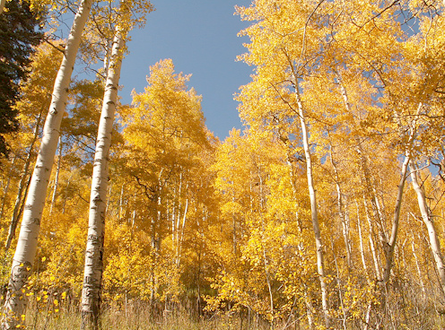No More Aspens By 2090?

Fall is the best secret season in the mountains: The afternoon thunderstorms of summer peter out even while the days stay warm, and most swarms of mountain lovers shack up until the first snowfall means they can start waxing their skis. And though a few snowbirds trip out to look for fall foliage on the roads, chances are you can hike to a solitary grove of golden aspens and have it all to yourself.
Leave it to climate change to freaking ruin it all: Droughts and rising temperatures are causing a major die-off of aspens in the American West, which foresters call “sudden aspen decline,” or SAD. Colorado’s SAD-afflicted acreage has quadrupled from 2006 to 2008, affecting more than 850 square miles. Utah, Wyoming, and Idaho have experienced similar conditions.
Scientists warn that in some worst-case scenarios, aspens could vanish from the Rocky Mountains entirely by the end of this century. The Rocky Mountain Research Station in Moscow, Idaho predicted a near total disappearance of aspen in the Rockies by 2090. (Aspen the resort is gonna be so pissed.)
“Assuming climate predictions are true, it probably is a sign of things to come,” said Jim Worrall, forest pathologist with the U.S. Forest Service.
“What we think will happen is that aspen will disappear in some areas and there will not be anything we can do about it,” said SAD expert Wayne Shepperd of Colorado State University.
Other scientists are reluctant to base aspen population predictions on climatological models, but even slight reductions in aspen populations pose major problems for humans and nature alike. Beyond weakening a forest ecosystem already ravaged by pine beetles, any imminent aspen die-offs threaten tourism, sawmill industries, and the elk populations that hunting industries rely on.
What can we do? Not much, unless you know a way to increase snowfall and rain while decreasing summer heat across a third of the continent. Any ideas? Me either.
—Ted Alvarez
Fall colors fade in U.S. West as aspen trees die (MNN)
Image Credit: msn678